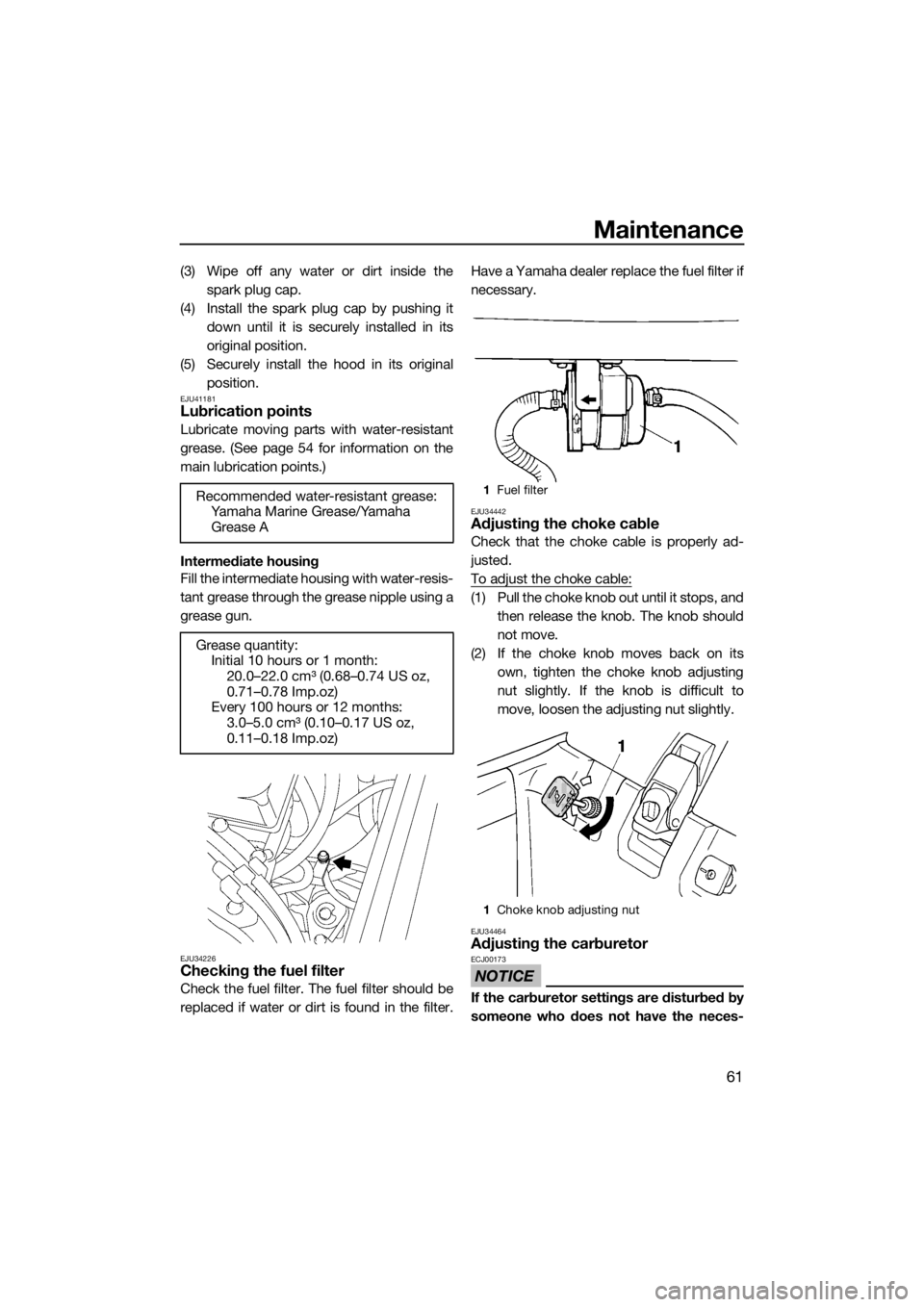2014 YAMAHA SUPERJET maintenance
[x] Cancel search: maintenancePage 66 of 78

Maintenance
60
EJU34379Checking the spark plugs
WARNING
EWJ00351
Be careful not to damage the insulator
when removing or installing a spark plug.
A damaged insulator could allow sparks to
escape, which could result in a fire or ex-
plosion.
Remove and check the condition of the spark
plugs.
The condition of a spark plug can indicate
something about the condition of the engine.
For example, if the center electrode portion is
very white, this could indicate an intake air
leak or carburetion problem in that cylinder.
Do not attempt to diagnose any problems
yourself. Have a Yamaha dealer service the
watercraft.
To remove a spark plug:
(1) Remove the hood. (See page 24 for hood
removal and installation procedures.)
(2) Remove the spark plug cap.
(3) Remove the spark plug, and then check
the condition of the spark plug and the
spark plug gap. If the electrode portion is
significantly discolored, if electrode ero-
sion becomes excessive, if carbon and
other deposits are excessive, or if the
spark plug gap is not within the specified
range, replace the spark plug.
TIP:
When the engine is operating normally, the
color of the spark plug electrode portion will
be a medium-to-light tan.
To install a spark plug:
(1) Wipe off any dirt from the threads, insu-
lator, and gasket surface of the spark
plug.
(2) Install the spark plug, and then tighten it
to the specified torque.
TIP:
If a torque wrench is not available when you
are installing a spark plug, a good estimate of
the correct torque is 1/4 turn to 1/2 turn past
finger tight using the spark plug wrench in-
cluded in the tool kit. Have the spark plug ad-
justed to the correct torque with a torque
wrench as soon as possible.
1Insulator
2Electrode
3Spark plug gap
Specified spark plug:
BR7HS
Spark plug gap:
0.6–0.7 mm (0.024–0.028 in)
Tightening torque:
Spark plug:
25.0 Nm (2.55 kgf-m, 18.4 ft-lb)
UF2F76E0.book Page 60 Thursday, May 9, 2013 3:52 PM
Page 67 of 78

Maintenance
61
(3) Wipe off any water or dirt inside the
spark plug cap.
(4) Install the spark plug cap by pushing it
down until it is securely installed in its
original position.
(5) Securely install the hood in its original
position.
EJU41181Lubrication points
Lubricate moving parts with water-resistant
grease. (See page 54 for information on the
main lubrication points.)
Intermediate housing
Fill the intermediate housing with water-resis-
tant grease through the grease nipple using a
grease gun.
EJU34226Checking the fuel filter
Check the fuel filter. The fuel filter should be
replaced if water or dirt is found in the filter.Have a Yamaha dealer replace the fuel filter if
necessary.
EJU34442Adjusting the choke cable
Check that the choke cable is properly ad-
justed.
To adjust the choke cable:
(1) Pull the choke knob out until it stops, and
then release the knob. The knob should
not move.
(2) If the choke knob moves back on its
own, tighten the choke knob adjusting
nut slightly. If the knob is difficult to
move, loosen the adjusting nut slightly.
EJU34464Adjusting the carburetor
NOTICE
ECJ00173
If the carburetor settings are disturbed by
someone who does not have the neces- Recommended water-resistant grease:
Yamaha Marine Grease/Yamaha
Grease A
Grease quantity:
Initial 10 hours or 1 month:
20.0–22.0 cm³ (0.68–0.74 US oz,
0.71–0.78 Imp.oz)
Every 100 hours or 12 months:
3.0–5.0 cm³ (0.10–0.17 US oz,
0.11–0.18 Imp.oz)
1Fuel filter
1Choke knob adjusting nut
UF2F76E0.book Page 61 Thursday, May 9, 2013 3:52 PM
Page 68 of 78

Maintenance
62
sary technical knowledge, poor engine
performance and damage may result.
The carburetor is a vital part of the engine and
requires very sophisticated adjustments.
Most adjustments should be left to a Yamaha
dealer who has the professional knowledge
and experience to make them.
However, the operator may adjust the engine
idling speed as part of the usual maintenance
routine.
EJU34472Adjusting the engine idling speed
(1) Place the watercraft in the water.
(2) Start the engine and warm it up for 1 to 2
minutes.
(3) While using a diagnostic tachometer,
turn the throttle stop screw to adjust the
engine idling speed to specification. Turn
the throttle stop screw clockwise to in-
crease the engine idling speed or coun-
terclockwise to decrease the engine
idling speed.
1Throttle stop screw
Engine idling speed:
1300 ±50 r/min
UF2F76E0.book Page 62 Thursday, May 9, 2013 3:52 PM
Page 76 of 78

Index
2-stroke engine oil ................................... 28
A
After removing the watercraft from the
water ..................................................... 49
B
Battery care.............................................. 51
Battery checks ......................................... 36
Battery, jumping ....................................... 67
Beaching the watercraft ........................... 49
Bilge water check..................................... 36
Bilge water, draining ................................ 30
Bilge water, draining on water ................. 30
Boarding and starting in deep water........ 47
Boarding and starting in shallow water.... 46
Bow rope hole .......................................... 25
C
Capsized watercraft ................................. 48
Carburetor, adjusting ............................... 61
Choke cable, adjusting ............................ 61
Choke knob.............................................. 21
Cleaning ................................................... 54
Cleaning the watercraft ............................ 51
Cooling water pilot outlet ......................... 21
Cooling water pilot outlet check .............. 39
Craft Identification Number (CIN)............... 1
Cruising limitations..................................... 9
E
Emergency procedures ............................ 66
Engine break-in ........................................ 32
Engine compartment check ..................... 35
Engine idling speed, adjusting ................. 62
Engine overheat warning system ............. 22
Engine serial number ................................. 1
Engine shut-off cord (lanyard) check ....... 38
Engine shut-off switch ............................. 19
Engine stop switch................................... 19
Engine unit check..................................... 36
Enjoy your watercraft responsibly............ 15
Equipment ................................................ 24
F
Fire extinguisher check ............................ 39
Fire extinguisher container....................... 26
Fire extinguisher container checks .......... 39
Flushing the cooling water passages....... 50Fuel .......................................................... 28
Fuel and engine oil requirements ............. 28
Fuel cock knob......................................... 21
Fuel filter, checking .................................. 61
Fuel level check........................................ 35
Fuel system checks ................................. 35
Fuel tank, filling ........................................ 29
Fuse, replacing ......................................... 67
G
Getting to know your watercraft .............. 40
Glossary, watercraft ................................. 16
H
Hazard information................................... 13
Hood ........................................................ 24
Hood check .............................................. 39
Hull and deck check ................................ 39
I
Identification numbers ............................... 1
J
Jet intake and impeller, cleaning.............. 66
Jet intake checks ..................................... 39
Jet thrust nozzle angle, adjusting ............ 57
Jumper cables, connecting ...................... 67
L
Labels, important ....................................... 3
Labels, other .............................................. 7
Labels, warning .......................................... 4
Launching the watercraft ......................... 41
Learning to operate your watercraft......... 40
Leaving the watercraft.............................. 43
Limitations on who may operate the
watercraft ................................................ 8
Long-term storage ................................... 54
Lubrication ............................................... 54
Lubrication points .................................... 61
M
Main components, location of ................. 17
Maintenance............................................. 56
Manufactured date label ............................ 2
Mixing fuel and oil .................................... 28
O
Operating in weeded areas ...................... 49
Operating positions .................................. 40
Operating the watercraft .......................... 43
Operating your watercraft ........................ 40
UF2F76E0.book Page 1 Thursday, May 9, 2013 3:52 PM
Page 77 of 78

Index
Operation requirements ........................... 10
P
Periodic maintenance chart ..................... 59
Post-launch checks ................................. 39
Post-operation care ................................. 50
Pre-launch checks ................................... 35
Pre-operation check points ..................... 35
Pre-operation checklist ............................ 33
Primary Identification (PRI-ID) number ...... 1
R
Recommended equipment ...................... 12
Rustproofing ............................................ 55
S
Safe boating rules .................................... 14
Safety equipment check .......................... 39
Spark plugs, checking ............................. 60
Start switch .............................................. 19
Starting off ............................................... 45
Starting the engine on water .................... 41
Steering friction, adjusting ....................... 56
Steering pole ............................................ 20
Steering pole check ................................. 37
Steering system ....................................... 20
Steering system checks ........................... 36
Stern rope hole ........................................ 25
Stopping the engine ................................. 43
Stopping the watercraft ........................... 45
Storage pouch ......................................... 25
Storage pouch checks ............................. 38
Submerged watercraft ............................. 69
Switch checks .......................................... 38
T
Throttle lever ............................................ 20
Throttle lever checks ................................ 37
Tool kit ..................................................... 56
Towing the watercraft .............................. 68
Transporting ............................................. 31
Troubleshooting ....................................... 64
Troubleshooting chart .............................. 64
Turning the watercraft .............................. 43
W
Water separator ....................................... 22
Water separator check............................. 36
Watercraft characteristics ........................ 13
Watercraft control functions .................... 19
UF2F76E0.book Page 2 Thursday, May 9, 2013 3:52 PM